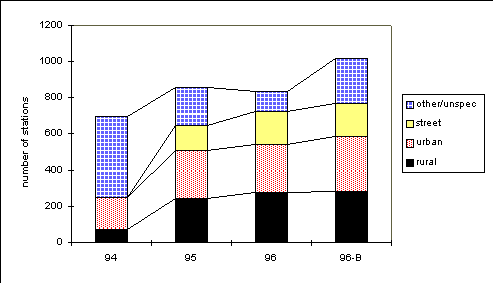2. DATA REPORTING
2.1 Introduction
According to the ozone directive, the EU Member States have to provide
the following information for the annual reference period:
- maximum, median and 98 percentile value of 1h- and 8h- average
concentrations;
- the number, date and duration of periods during which threshold values as
presented in Table 1 are exceeded and the maximum concentrations recorded during each
occurrence.
In addition to this annual report, Member States must inform the
Commission on a monthly basis if exceedances of the information and warning threshold
values are observed.
Table 1. Threshold values for ozone concentrations (in µg/m3)
| threshold for |
concentration |
averaging period |
| health protection vegetation protection
" "
population information
population warning |
110
200
65
180
360 |
8 h
1 h
24 h
1 h
1 h |
A group of experts from the Members States have followed the practical implementation
of the Directive. Among other items this group discussed procedures for data reporting.
The formats for information and data exchanges have been defined in the document
"Council Directive 92/72/EEC on air pollution by ozone. Information and data
exchange/formats", Doc.Rev. 11/243/95. In general terms, the requested information
consists of two parts:
- information on stations and measurements techniques (Ozone Directive, article 4.2,
indents 1 and 2);
- information on ozone concentration: annual statistics and threshold exceedances (Ozone
Directive, article 6.1).
Based on the experiences in processing the data for the 1994 annual report, the
European Topic Centre on Air Quality (ETC-AQ) provided remarks concerning data
transmission and suggestions for improvement which were discussed in the Expert Group on
Photochemical Pollution. Considering the increasing amount of data requiring processing,
as well as the improvement of the transfer of data relating to the implementation of the
Directive, the Commission has prepared an update (April 1996) of the data exchange format.
The major changes concern the transfer of additional information:
- type of station: definition of the location of stations as recommended in the decision
on Exchanges of Information (97/101/EC);
- altitude of stations as recommended by the Expert Group;
- NOx and VOC data, according to Annex 2.3 of the ozone directive;
- file names: it is recommended to define unique names for all files in order to improve
the management and transfer of the data files.
For submission of the 1996 data no further modifications in data requirements and data
exchange formats have been made.
2.2 Data handling
According to the Ozone Directive, the requested information over 1996
should have been forwarded to the Commission before 1 July 1997. All data forwarded by the
Commission and received at the European Topic Centre on Air Quality (ETC-AQ) before 11
August 1997 has been processed is this report. In this report the definition of the data
formats as described in the document Doc.Rev. 11/243/95 and its April 1996 amendment is
used as a reference. If necessary, files were converted at the ETC-AQ for further
processing.
No information has been received from France. Information from Italy was
received more than two months after the formal deadline of 1 July. The received data were,
however, not fully in agreement with the standard data format which impeded data analyses.
As time and resources were limited, the Italian data has not been included fully in this
report. However, as far as possible the Italian data are included in the overview Tables
2-6 and a preliminary survey of exceedances in Italy is presented in Chapter 4.6.
For 1996 information on ozone concentrations (annual statistics and/or
exceedance information) was received for 836 monitoring stations. For nearly all stations
information was submitted on measurement methods, instruments and calibration procedures.
In comparison to 1995, information for a slightly smaller number of stations was received
(see Figure 1). Comparison of 1995 and 1996 is hampered by the fact that information from
two Member States is missing. If one assumes that in those countries the same number of
stations is operational in 1995 and 1996, there is an increase in information, see the bar
labelled 96-B in Figure 1.
Information on NOx concentrations has been received from 6
Member States (90 stations); 8 Member States reported on NO2 concentrations
(122 stations). Information on Volatile Organic Compounds (VOC) was reported by two Member
States at five stations.

Figure 1. Number of stations reporting ozone data within the
framework of the Ozone Directive. The bar "96" refers to the actual 13 reporting
Member States; in "96-B" a correction has been made for missing data.


Document Actions
Share with others